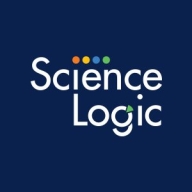

SCOM and ScienceLogic compete in the IT infrastructure monitoring category, with each offering distinct advantages. ScienceLogic holds an edge in device and event monitoring, while SCOM excels in Microsoft application integration.
Features: SCOM delivers extensive capabilities for Microsoft applications, such as application performance monitoring and automated alert notifications. It benefits from deep integration with other Microsoft products and allows significant customization through Visual Studio. ScienceLogic is known for excellent device and event monitoring capabilities, multi-tenancy support, and built-in automation. Its flexible integrations allow for comprehensive monitoring of AWS and on-site resources, and users value its customizable dashboards and predictive analytics.
Room for Improvement: SCOM requires development in multi-tenancy and needs to reduce administrative overhead and address GUI performance issues. Enhancing cloud and non-Microsoft product monitoring, as well as simplifying extended configurations, is also crucial. ScienceLogic could improve scalability options and UI for simpler task execution. Enhanced reporting capabilities and more out-of-the-box functionalities are also necessary to streamline operations and reduce manual interventions.
Ease of Deployment and Customer Service: SCOM is preferred for its on-premises deployment, integrating smoothly with Microsoft environments, and benefitting from robust support, especially with a Microsoft Premier agreement. ScienceLogic supports both on-premises and private cloud solutions and provides effective customer service and technical support for installation, configuration, and regular use.
Pricing and ROI: SCOM often comes bundled with the System Center suite under enterprise agreements, making it cost-effective for Microsoft product-focused businesses, although users find ROI calculations challenging yet recognize efficient monitoring as key. ScienceLogic's pricing can increase with the number of monitored devices, yet users justify the investment due to its feature set and flexibility. Both products offer a return mainly through enhanced infrastructure visibility and operational efficiency.
The return on investment is fair but often challenged by medium-sized businesses who may question its adequacy.
We have a lab environment to test solutions before offering them to customers, ensuring everything works correctly.
I received excellent support from ScienceLogic.
Problems with Skylar may require longer wait times due to limited resource expertise.
They often treat issues in isolation, not considering how one problem might relate to another.
When I was working directly with Microsoft at TCS, my first company, the support experience was quite smooth, and we received solutions promptly.
The scalability of SCOM, meaning its ability to adapt to our needs, is excellent because we are working with SQL systems and multiple servers.
The stability rating is nine out of ten, acknowledging some bugs, but indicating these are minor issues.
I have not seen many errors or frequent data loss because once we have installed the agent on the system and have the details, not much manual intervention is required.
SCOM is a bit unstable lately, primarily due to a lack of resources.
While some other companies have easier APIs, using this solution demands significant expertise.
If the knowledge for implementation could be spread through articles, it would reduce this dependency.
Integrating observability and APM monitoring into the overall portfolio would be beneficial.
I would like to see a software-as-a-service version in Azure to eliminate the need for on-premise infrastructure.
SCOM is likely to be phased out in favor of more compatible tools like Icinga for application monitoring or when moving to cloud solutions like CloudWatch and Azure.
It would be beneficial to have a summary on one single dashboard, as there are many more possibilities available.
It could be cheaper.
ScienceLogic is not that expensive and is cost-effective overall.
Notably, its automation features, such as Runbook action, enable domain experts like me to execute one-click automation solutions, which contributes significantly to reducing MTTR.
The solution excels in three areas: application monitoring, server monitoring, and network performance monitoring.
The CMDB update and the automatic CMDB update are valuable.
It assists me in detecting server downtime and delivers basic performance monitoring right out of the box.
The most valuable feature of SCOM is its monitoring capability, and we have integrated SCOM with Grafana, which is a dashboarding tool.
SCOM integrates several systems and offers correlation features, like setting up everything around Active Directory or DNS.
| Product | Market Share (%) |
|---|---|
| SCOM | 9.1% |
| ScienceLogic | 6.2% |
| Other | 84.7% |

| Company Size | Count |
|---|---|
| Small Business | 13 |
| Midsize Enterprise | 11 |
| Large Enterprise | 24 |
| Company Size | Count |
|---|---|
| Small Business | 16 |
| Midsize Enterprise | 22 |
| Large Enterprise | 54 |
ScienceLogic excels in customizable dashboards, seamless integrations, and real-time data analysis, supporting diverse IT environments with multi-tenant capabilities.
ScienceLogic provides robust infrastructure and network monitoring, catering to cloud, applications, and server environments. It supports hybrid setups, integrating with CMDB and ticketing systems while automating incident management. ScienceLogic's PowerPacks eliminate visibility gaps and its adaptable nature supports modern and legacy systems. Offering agentless monitoring, it ensures efficient operations with scalable infrastructure support and detailed reporting. However, the interface complexity and need for professional support can present usability challenges. Enhancements in reporting, application coverage, API support, and customization are desirable for improved user experience.
What are ScienceLogic's most important features?ScienceLogic is often implemented across industries requiring detailed attention to infrastructure and network monitoring. It finds utility in managing hybrid environments, integrating seamlessly with essential systems like CMDB and ticketing platforms. Its scalability and adaptability are valued in unifying complex, diverse environments under one monitoring platform.
SCOM (System Center Operations Manager) is a cross-platform data center monitoring and reporting tool that checks the status of various objects defined within the environment, such as server hardware, system services, etc. The solution allows data center administrators to deploy, configure, manage, and monitor the operations, services, devices and applications of multiple enterprise IT systems via a single pane of glass. It is suitable for businesses of all sizes.
SCOM Features
SCOM has many valuable key features. Some of the most useful ones include:
SCOM Benefits
There are several benefits to implementing SCOM. Some of the biggest advantages the solution offers include:
Reviews from Real Users
Below are some reviews and helpful feedback written by PeerSpot users currently using the SCOM solution.
A Manager at a financial services firm says, “The feature I like most about SCOM is that it is easy-to-use. I find it very user-friendly. I also like the knowledge base which it has. You can find the resolution to questions or issues directly within the SCOM itself. It will alert you with a recommendation of what you need to do at the same time. This sort of self-diagnosis or prompting is one of the great values you get from SCOM compared to other solutions.”
PeerSpot user Zahari Z., Information Technology Auditor at a financial services firm, mentions, “Availability monitoring is the feature I have found most valuable, as well as the capacity and ability to send notifications. There is a mechanism to set up a notification from the SCOM and whenever there is a drop in the availability the notification alerts not only for availability but for other issues as well. You can align thresholds according to the speed of your environment and you can have a threshold related notification, which is one of the useful features.”
Bill W., Sr. Systems Engineer at Arapahoe County Government, comments, “ I like some of their newer features, such as maintenance schedules, because SCOM records SLA and SLO time. When we patch, things are automatically put into maintenance mode so that the numbers for our systems being down, do not count against us.”
A Project Manager at a tech services company explains, “The feature I have found most valuable is the book feature. While we run the Sprint one we can add some setups for multiple sprints.”
A Systems Engineer at an educational organization states, “Because it's Windows-based, it actually reports quite well. It reports everything you can think of on the Windows server and allows you to monitor anything. It's excellent for those in the Windows world as it's very good at it.”
We monitor all Event Monitoring reviews to prevent fraudulent reviews and keep review quality high. We do not post reviews by company employees or direct competitors. We validate each review for authenticity via cross-reference with LinkedIn, and personal follow-up with the reviewer when necessary.